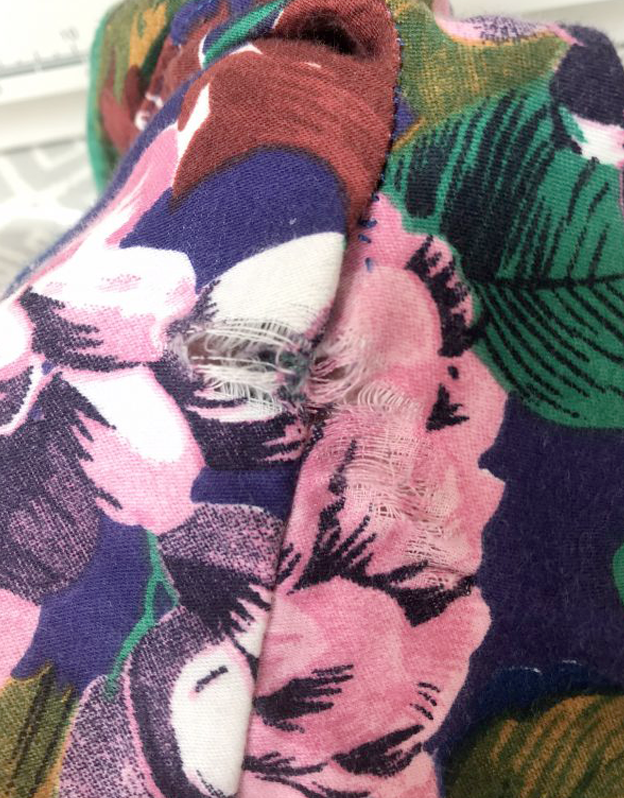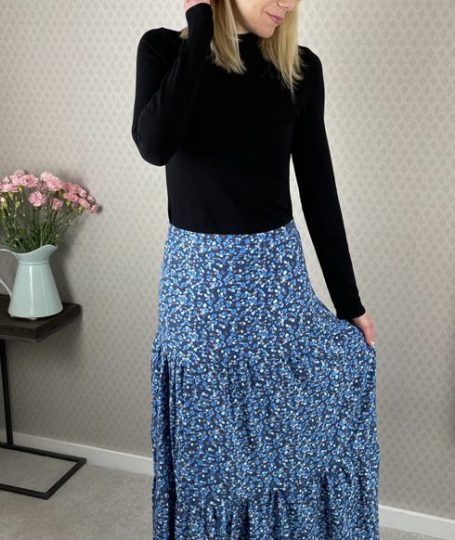Imagine my distress when I realised that one of my handmade garments had a big tear in the fabric underneath the arms! My beloved Tilly and the Buttons Stevie dress! This was not just a small tear but quite a large one, extending across the underarm seam and would definitely get worse unless I fixed it.

It doesn’t have to be a handmade garment though – maybe your favourite shirt, pair of jeans, kid’s trousers – wherever it is, it’s annoying, but it happens. With the world facing climate change, the trend of fast fashion and the realisation of the harmful effects to the environment of throwing clothes away, we are in an era when we are being encouraged to repair and recycle, not throw away. But this is not actually a new thing.
‘Make do and mend’ was an initiative that was heavily publicised during World War II. I found a copy of the Make Do and Mend pamphlet in a charity shop, first published in 1943. It’s a fascinating read!

It contains lots of hints and tips on how to make the most of your clothes, look after them properly in order for them to last longer and how to mend clothes and household linen. Knowing how to sew and be able to perform simple repairs is a skill for life and certainly one that will help save money and reduce the negative impact on the environment that throwing away garments can have. It will also allow further enjoyment of much loved items of clothing! Amazing!
So back to my dress. The edges of the fabric tear were frayed and it was more of a couple of frayed holes rather than a simple tear. I therefore decided to use some fusible interfacing to help stabilise the fabric and provide a base for the machine stitching.
Interfacing is a product that is designed to help provide structure and rigidity to fabric. It comes in a variety of different weights, colours (most common are black and white) and can be fusible (iron on) or non-fusible (sew in). It can be used for a whole variety of purposes including stiffening waistbands and collars and also prevent stretching out of fabric, for example a stretch interfacing can be used for hemming knits. You should ideally use a similar weight interfacing to the weight of fabric you are using for your project e.g. a lightweight interfacing for a lightweight fabric like chiffon.
A useful introduction to interfacing can be seen here.
My dress is made out of a medium weight woven brushed cotton. Therefore in order to repair my dress, I chose to use a woven fusible interfacing by Vlieseline (G700)***. It is recommended for use on lightweight to medium weight fabrics and can be bought from Lady Sew and Sew here.
I noticed that the tear had gone across the side seam of the dress as the side seam stitching had come undone around that area. I decided to re-sew the side seam first and then treat the tears as 2 separate repairs – one on the front of the dress and one on the back.

The first tear I decided to repair was the one just in front of the side seam on the front section of the fabric, not actually that far from the front pocket.

I firstly cut an oval piece of the interfacing approximately 1-2 cm bigger than the hole itself. This is then placed on the reverse side of the fabric over the hole, bringing together the edges of the hole where possible. The fusible interfacing has a matt side to it and a shiny side. The shiny side is the glue side so you must make sure that it is placed shiny side down facing the fabric (otherwise you will get a hideous sticky mess on your iron which is not pretty!!). The manufacturer’s instructions say to use a 3 dot heat on the iron and to hold for 12 seconds. It is always advisable to test a small piece on a scrap of fabric first of all. Once the interfacing has fused, the edges should be stuck down nicely and not coming away. For small tears, just doing this alone may be sufficient to repair the tear. I decided however, to reinforce further with machine stitching.

I matched the colour of the thread with the colour of the fabric. This can be somewhat of a challenge when the fabric has lots of colours in it and the tear extends across several areas. I would go with the predominant colour or change thread colours for different parts of the tear which is what I decided to do. I started with white thread and using a straight stitch on the machine, carefully sewed back and forth across the whole area of the tear, using the reverse button on the machine. If you have a speed setting on your machine it might be worth slowing it down until you are comfortable.
I then changed my thread colour to pink in order to reinforce the part of the tear over the pink part of the flower.
-

White stitching…. -

then pink stitching
This is what it looks like from the reverse.

I then repeated the process on the other side of the seam using just pink thread this time.
-

Interfacing applied to the wrong side of the fabric tear -

Pink stitching reinforcing over the tear -

How the repair looks from the reverse
I am super pleased with the repair job. It can be a bit time consuming and clearly not as exciting as making something new! I am confident however, that this will work and allow me to continue enjoying wearing my dress which is clearly worth the time and effort. It obviously doesn’t look as good as if the tear wasn’t there but I couldn’t have worn it without trying to do something to it. Hopefully it won’t be too noticeable in the position that it is in and won’t stick out like a sore thumb!! Every stitch has a story though so I’m not too fussed!! It has also washed well so fingers crossed it does the job!!

Other techniques to try would be using patches over holes for example in jeans or jumpers – why not make a feature of it instead of trying to disguise it? Sashiko is also an interesting technique that originates from Japan. It is a form of decorative stitching that is traditionally used to reinforce points of wear or to repair worn places. It is being recognised in the sewing community as a very slow and mindful technique. Sounds awesome right?
How about you – Do you take the time out to repair clothes? Do you have a pile of clothes people have given you to fix but the lure of new projects takes priority??!! Do you have any tried and tested techniques?
***The interfacing was gifted to me for the purpose of a review. All opinions are completely honest and are my own.





